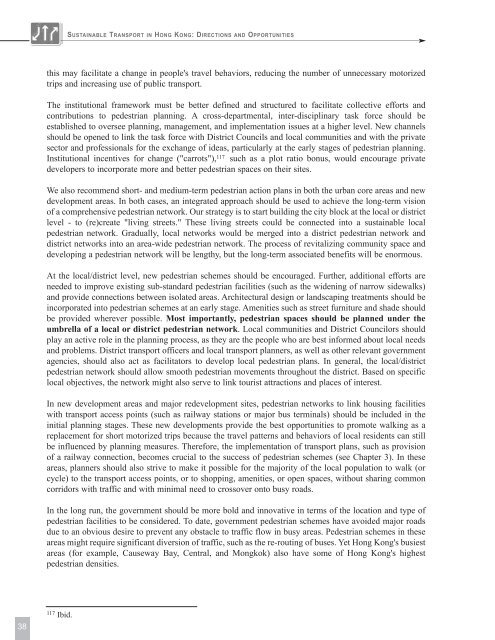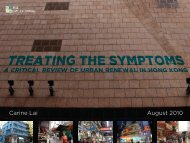Untitled - Civic Exchange
Untitled - Civic Exchange
Untitled - Civic Exchange
Create successful ePaper yourself
Turn your PDF publications into a flip-book with our unique Google optimized e-Paper software.
SUSTAINABLE TRANSPORT IN HONG KONG: DIRECTIONS AND OPPORTUNITIES<br />
this may facilitate a change in people's travel behaviors, reducing the number of unnecessary motorized<br />
trips and increasing use of public transport.<br />
The institutional framework must be better defined and structured to facilitate collective efforts and<br />
contributions to pedestrian planning. A cross-departmental, inter-disciplinary task force should be<br />
established to oversee planning, management, and implementation issues at a higher level. New channels<br />
should be opened to link the task force with District Councils and local communities and with the private<br />
sector and professionals for the exchange of ideas, particularly at the early stages of pedestrian planning.<br />
Institutional incentives for change ("carrots"), 117 such as a plot ratio bonus, would encourage private<br />
developers to incorporate more and better pedestrian spaces on their sites.<br />
We also recommend short- and medium-term pedestrian action plans in both the urban core areas and new<br />
development areas. In both cases, an integrated approach should be used to achieve the long-term vision<br />
of a comprehensive pedestrian network. Our strategy is to start building the city block at the local or district<br />
level - to (re)create "living streets." These living streets could be connected into a sustainable local<br />
pedestrian network. Gradually, local networks would be merged into a district pedestrian network and<br />
district networks into an area-wide pedestrian network. The process of revitalizing community space and<br />
developing a pedestrian network will be lengthy, but the long-term associated benefits will be enormous.<br />
At the local/district level, new pedestrian schemes should be encouraged. Further, additional efforts are<br />
needed to improve existing sub-standard pedestrian facilities (such as the widening of narrow sidewalks)<br />
and provide connections between isolated areas. Architectural design or landscaping treatments should be<br />
incorporated into pedestrian schemes at an early stage. Amenities such as street furniture and shade should<br />
be provided wherever possible. Most importantly, pedestrian spaces should be planned under the<br />
umbrella of a local or district pedestrian network. Local communities and District Councilors should<br />
play an active role in the planning process, as they are the people who are best informed about local needs<br />
and problems. District transport officers and local transport planners, as well as other relevant government<br />
agencies, should also act as facilitators to develop local pedestrian plans. In general, the local/district<br />
pedestrian network should allow smooth pedestrian movements throughout the district. Based on specific<br />
local objectives, the network might also serve to link tourist attractions and places of interest.<br />
In new development areas and major redevelopment sites, pedestrian networks to link housing facilities<br />
with transport access points (such as railway stations or major bus terminals) should be included in the<br />
initial planning stages. These new developments provide the best opportunities to promote walking as a<br />
replacement for short motorized trips because the travel patterns and behaviors of local residents can still<br />
be influenced by planning measures. Therefore, the implementation of transport plans, such as provision<br />
of a railway connection, becomes crucial to the success of pedestrian schemes (see Chapter 3). In these<br />
areas, planners should also strive to make it possible for the majority of the local population to walk (or<br />
cycle) to the transport access points, or to shopping, amenities, or open spaces, without sharing common<br />
corridors with traffic and with minimal need to crossover onto busy roads.<br />
In the long run, the government should be more bold and innovative in terms of the location and type of<br />
pedestrian facilities to be considered. To date, government pedestrian schemes have avoided major roads<br />
due to an obvious desire to prevent any obstacle to traffic flow in busy areas. Pedestrian schemes in these<br />
areas might require significant diversion of traffic, such as the re-routing of buses. Yet Hong Kong's busiest<br />
areas (for example, Causeway Bay, Central, and Mongkok) also have some of Hong Kong's highest<br />
pedestrian densities.<br />
117 Ibid.<br />
38

















